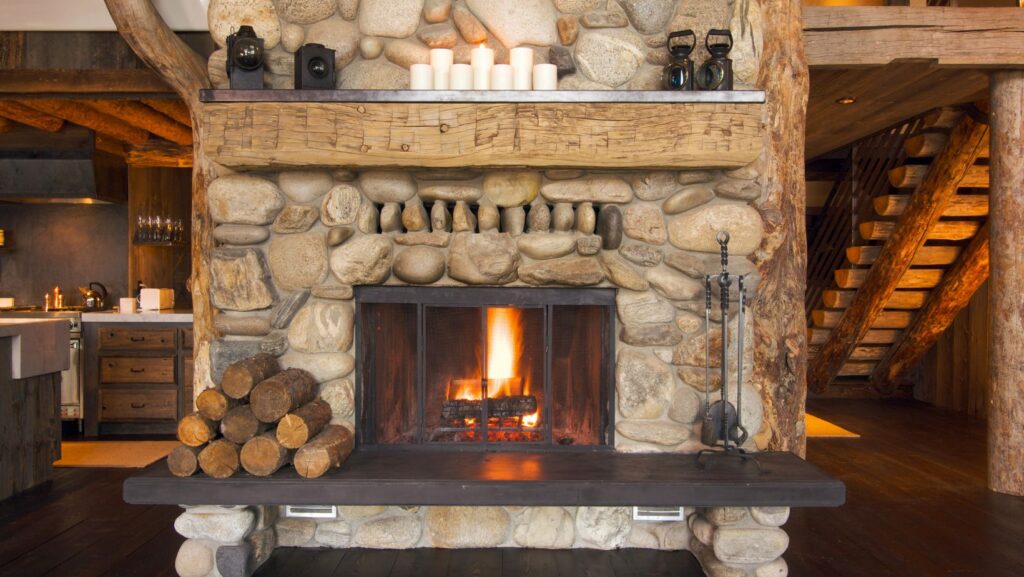Antique wood fireplaces add a unique warmth and character to any modern home, blending old-world charm with contemporary design. The intricate craftsmanship and rich wood patina bring authenticity and appeal that modern heating options can’t replicate.
Integrating these timeless pieces into contemporary homes does more than heat the room; they become a visual and functional centerpiece. Whether in a cozy living room or a quaint bedroom, they make spaces welcoming and enhance the decor by combining historical elegance with modern style.
Antique wood fireplaces offer more than warmth—they enrich the environment with their history and charm, making any home feel both inviting and stylish. Adding these pieces allows homeowners to enjoy a functional living space that also celebrates a rich historical legacy.
In this article, we will discuss how to select the right antique wood fireplace for your home, considering factors such as size, style, and compatibility with your home’s architecture. We will also delve into the best practices for restoring and maintaining these historic pieces to ensure their safety, efficiency, and aesthetic appeal.
How To Select the Right Antique Wood Fireplace
Choosing the perfect antique fireplace involves careful consideration to ensure it harmonizes with your home’s architectural style and interior design. Start by evaluating the size of the fireplace and the space where it will be installed. Ensure it fits proportionally without overpowering the room or appearing cramped.
Next, consider the style of the fireplace and how it complements your home’s overall aesthetic. Whether you prefer a rustic, country-style fireplace or an elegant, ornate design, select a fireplace that aligns with your interior design theme.
Assess the condition of the fireplace, paying attention to any signs of wear, damage, or structural issues. While some imperfections add to the charm of an antique piece, ensure the fireplace is structurally sound and safe for use.
Additionally, consider the type of fuel the fireplace was designed to burn. Antique wood fireplaces are typically designed for burning wood, but some may be compatible with other fuels such as coal or gas. Choose a fireplace that suits your fuel preferences and meets any regulatory requirements in your area.
How To Restore and Maintain Antique Wood Fireplaces
Restoring and maintaining antique wood fireplaces is essential not only for preserving their historical charm but also for ensuring their safe and efficient operation. Here’s a detailed guide on the process and why hiring experienced professionals is crucial:
Chimney Inspection
Begin by inspecting the chimney to assess its condition and identify any potential hazards such as creosote buildup, cracks, or obstructions. A professional chimney sweeper can conduct a thorough inspection and perform necessary repairs to ensure proper ventilation and prevent chimney fires.
Masonry Repair
Antique wood fireplaces often feature intricate masonry work that may deteriorate over time due to age, weather exposure, or neglect. Hire experienced masons to repair any cracks, gaps, or loose bricks in the fireplace structure to restore its integrity and prevent further damage.
Fireplace Cleaning
Proper cleaning is essential for maintaining an antique fireplace. Remove ash, soot, and debris regularly to prevent buildup that can obstruct airflow and cause smoke to back up into the room.

Use mild cleaning agents and soft brushes to avoid damaging the delicate surfaces of the fireplace.
Professional Restoration
For extensive restoration work, such as repairing damaged mantels, refinishing wood surfaces, or replacing missing parts, enlist the services of experienced restoration specialists. They have the skills, tools, and expertise to carefully restore antique wood fireplaces to their former glory while preserving their historical integrity.
Routine Maintenance
Regular maintenance is key to ensuring the long-term performance and safety of an antique wood fireplace. Schedule annual inspections and cleanings by qualified professionals to address any issues promptly and keep the fireplace in optimal condition.
Safety Precautions
When using an antique wood fireplace, follow recommended safety precautions to prevent accidents and ensure safe operation. Install carbon monoxide and smoke detectors near the fireplace and have fire extinguishing equipment readily available. Never leave a fire unattended, and always use a fireplace screen to contain sparks and embers.
Incorporating Antique Wood Fireplaces into Your Home’s Design
Integrating antique wood fireplaces into your home’s decor requires thoughtful consideration to achieve a harmonious balance between historical charm and contemporary comfort. Here’s some guidance to successfully incorporate these timeless fixtures into your living spaces:
Mantel Design
The mantel of an antique wood fireplace serves as a focal point, making it crucial to choose a design that complements your home’s overall aesthetic. Opt for a mantel style that reflects the architectural period of your home, whether it’s ornate Victorian carvings, rustic farmhouse beams, or sleek Art Deco lines. Consider accessorizing the mantel with antique clocks, decorative vases, or framed artwork to enhance its visual appeal.
Hearth Materials
The material used for the hearth of an antique wood fireplace can significantly impact its appearance and functionality. Traditional options like brick or stone offer a rustic charm that complements the vintage appeal of the fireplace. For a more refined look, consider using marble or granite for the hearth, adding a touch of elegance to the space. Incorporate seating options like cushioned benches or antique chairs around the hearth to create a cozy gathering spot for family and guests.
Decorative Accessories
Enhance the ambiance of your fireplace with carefully curated decorative antique accessories that reflect your personal style and preferences. Antique fireplace tools, such as brass or wrought iron pokers, tongs, and brushes, add a touch of authenticity while serving a practical purpose. Adorn the mantlepiece with vintage mirrors, candle holders, or botanical arrangements to create a warm and inviting atmosphere.
Creating a Cohesive Aesthetic
To create a cohesive aesthetic that seamlessly blends historical charm with contemporary comfort, consider the overall design theme and color palette of your home. Choose complementary furniture, textiles, and decor accessories that complement the style of the antique wood fireplace while adding modern touches to update the look. Incorporate elements like plush area rugs, upholstered seating, and sleek lighting fixtures to balance the vintage appeal of the fireplace with contemporary comfort and functionality.
How To Use Antique Wood Fireplaces as Focal Points
Antique wood fireplaces possess inherent charm and character that make them ideal focal points within a room. Harnessing their potential as visual anchors can elevate the entire space. Here are some creative design strategies to enhance the visual impact of antique wood fireplaces:
Accent Lighting
Strategically placed lighting can draw attention to the fireplace and highlight its architectural features. Install wall sconces or recessed lights above or beside the fireplace to illuminate the mantel and create a warm ambiance.

Consider using adjustable spotlights to showcase specific details, such as intricate carvings or ornate molding, adding depth and drama to the focal point.
Custom Millwork
Enhance the presence of an antique wood fireplace with custom millwork that complements its style and proportions. Install built-in cabinetry or shelving units on either side of the fireplace to frame it and create a cohesive architectural statement. Incorporate decorative moldings, paneling, or trim work around the fireplace to add visual interest and emphasize its prominence in the room.
Unique Artwork Displays
Adorn the area above the mantel with unique artwork displays and antique frames that reflect your personal taste and style. Hang a large painting, framed mirror, or decorative tapestry to create a focal point that draws the eye and anchors the room. Consider rotating artwork seasonally or displaying a curated collection of vintage photographs, antique mirrors, or sculptural objects to refresh the look of the fireplace and add visual intrigue.
Statement Accessories
Use statement accessories to enhance the visual impact of the antique wood fireplace and infuse the space with personality. Display decorative objects, such as sculptural vases, ceramic figurines, or intricately carved candle holders, on the mantel or hearth to create visual interest and texture. Incorporate layers of texture and color through textiles, such as throws, pillows, or area rugs, to soften the surrounding space and add warmth and dimension.
Safety Considerations for Antique Wood Fireplaces
While antique wood fireplaces add charm and warmth to a home, it’s crucial to prioritize safety to prevent accidents and ensure a pleasant experience. Here are key safety precautions to consider:
Proper Ventilation
Adequate ventilation is essential to prevent the buildup of smoke, gases, and other harmful byproducts of combustion. Ensure your fireplace flue is clean and properly functioning to allow for the efficient removal of smoke and gases. Regular chimney inspections and cleanings by certified professionals are recommended to maintain optimal ventilation.
Fireproofing
Protect surrounding surfaces and furnishings from heat damage by installing fireproof materials such as fire-resistant hearth rugs, fireplace screens, and non-combustible wall coverings. Keep flammable items like curtains, furniture, and decorations at a safe distance from the fireplace to reduce the risk of accidental fires.
Smoke and Carbon Monoxide Detectors
Install smoke detectors near the fireplace and throughout your home to provide early warning in the event of a fire. Additionally, consider installing carbon monoxide detectors to monitor levels of this odorless, toxic gas emitted during combustion. Test detectors regularly and replace batteries as needed to ensure they remain operational.
Adherence to Building Codes and Guidelines
Familiarize yourself with local building codes and manufacturer guidelines governing the installation and operation of antique wood fireplaces. Ensure compliance with regulations regarding clearance distances, hearth size, chimney height, and other safety requirements. Hiring a certified professional to inspect and install your fireplace can help ensure adherence to these standards.
Conclusion
Incorporating antique wood fireplaces into a modern home adds unique aesthetic appeal and functional benefits. These fixtures not only provide warmth but also serve as versatile design elements that elevate ambiance and character. Homeowners should explore their potential to infuse historical charm into living spaces, creating a cozy atmosphere while preserving the rich heritage of the past.



